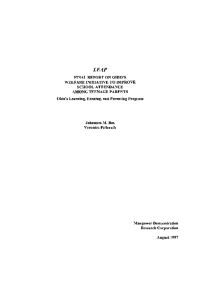LEAP
Final Report on Ohio’s Welfare Initiative to Improve School Attendance Among Teenage Parents
This is the fifth and final report from a multi-year evaluation of Ohio’s Learning, Earning, and Parenting (LEAP) Program. Developed and operated by the Ohio Department of Human Services (ODHS), LEAP is a statewide initiative that employs financial incentives in an attempt to increase school enrollment and attendance among pregnant teenagers and custodial teen parents on welfare (almost all of them are women). LEAP, which began operating in 1989, requires these teens to stay in school and attend regularly or, if they have dropped out, to return to school or enter a program to prepare for the General Educational Development (GED), or high school equivalency, test. The program thereby strives to increase the proportion of teens who graduate from high school or receive a GED, find jobs, and ultimately achieve self-sufficiency. These longer-term goals are important because, even though teen parents make up fewer than 10 percent of all Aid to Families with Dependent Children (AFDC) case heads, families started by women who first gave birth as teenagers account for approximately 50 percent of all long-term AFDC recipients.
During the period of this study (the rules have recently been modified), teens who met LEAP’s requirements had their welfare checks increased — $62 for school enrollment and an additional $62 each month they attended school regularly — and teens who did not (without an acceptable reason) had $62 deducted from their welfare grant every month until they complied with program rules. Those who exceeded the allowed number of total absences in a month but not the allowed number of unexcused absences qualified for neither a bonus nor a "sanction" (as such grant reductions are called). Teens could be temporarily exempted from LEAP’s requirements for medical reasons, to care for an infant, or if child care or transportation was unavailable. Teens were no longer subject to LEAP’s requirements when they reached the age of 20, left AFDC, or received a high school diploma or a GED. During 1992 — approximately the midpoint in the period covered by this report — a teen living on her own with one child (the most common situation) was eligible for a monthly AFDC grant of $274. Thus, a bonus raised her grant to $336 and a sanction reduced it to $212. If she went from being sanctioned to receiving a bonus, she would experience a 58 percent increase in her welfare grant.
Teens’ enrollment and attendance are monitored by case managers, who explain the program’s rules, offer guidance, and authorize assistance with child care and transportation teens may need to attend school. LEAP itself provides no other services, although many Ohio high schools have special programs, called GRADS (Graduation, Reality, and Dual-Role Skills), which are designed to assist teen parents in managing their dual roles as parents and students. Also, as part of the evaluation, an enhanced version of LEAP was put in place on a pilot basis in some Cleveland high schools; it offered school-based services such as child care and intensive case management as well as special GED classes and other services for teens who were not complying with LEAP.
The LEAP evaluation began with the start of the program itself and encompassed 12 Ohio counties, in which the large majority of LEAP teens resided. Previous reports described the program’s operations and analyzed LEAP’s effectiveness in achieving its education goals and in moving teens toward employment and self-sufficiency. The primary purpose of this final report is to present longer-term (four-year) effects of LEAP on the teens’ employment, earnings, and AFDC receipt and to assess the program’s cost-effectiveness.






